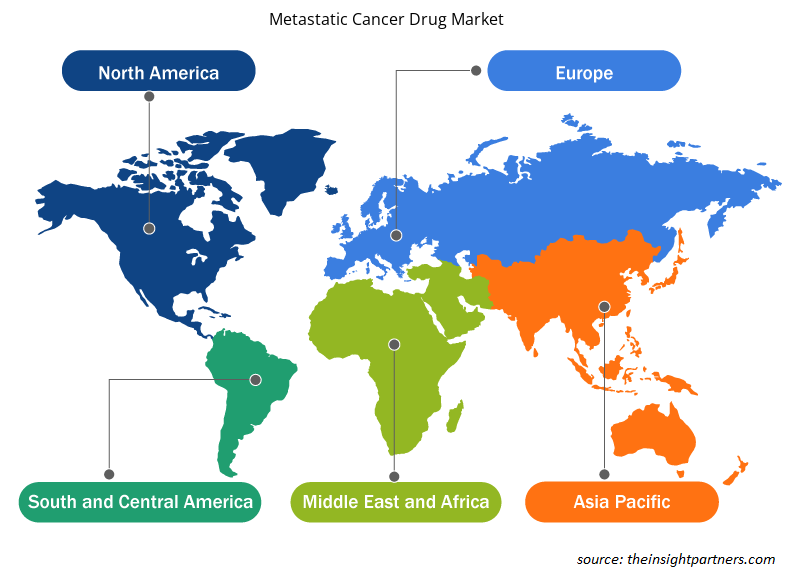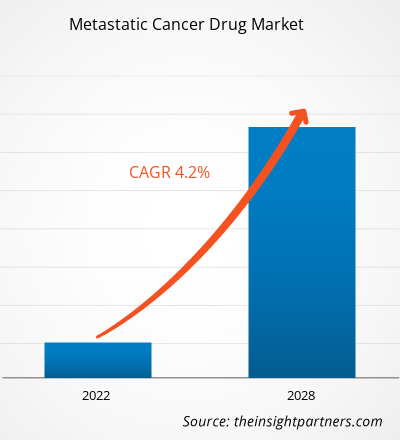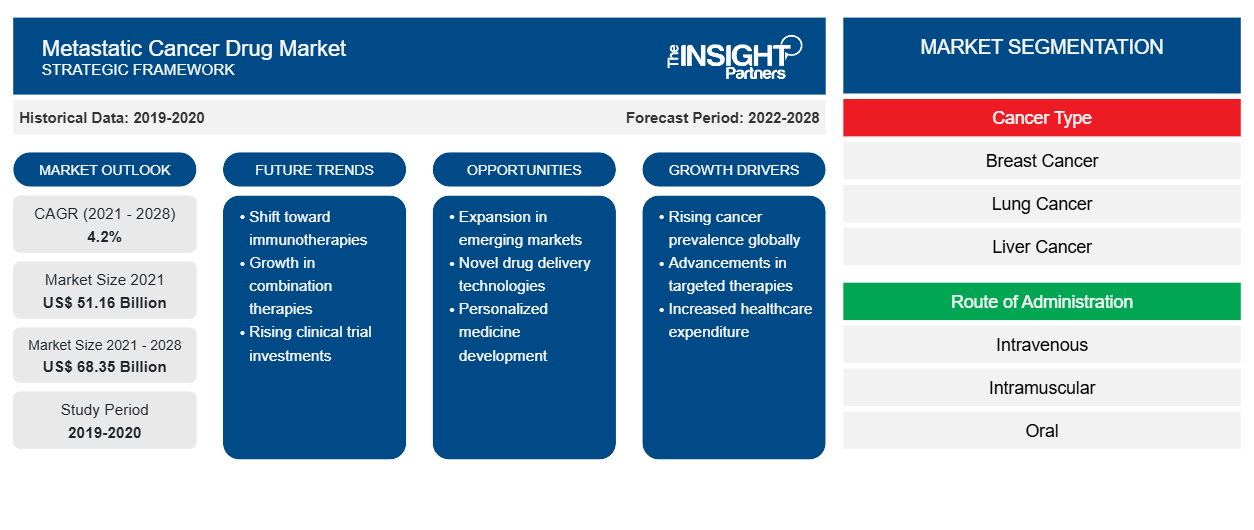[Rapport de recherche] La taille du marché des médicaments contre le cancer métastatique devrait atteindre 68 349,54 millions USD d'ici 2028, contre 51 157,97 millions USD en 2021. Il devrait croître à un TCAC de 4,2 % de 2021 à 2028.CAGR of 4.2% from 2021 to 2028.
Le cancer métastatique est défini comme un cancer à un stade avancé qui se propage à d'autres parties du corps. Les médicaments utilisés pour le traitement du cancer à un stade avancé sont appelés médicaments contre le cancer métastatique. Ces médicaments sont utilisés dans le cadre de diverses thérapies, telles que la chimiothérapie, l'immunothérapie et la thérapie ciblée. immunotherapy, and targeted therapy.
Le marché des médicaments contre le cancer métastatique est analysé en fonction du type de cancer, de la voie d'administration, de la classe de médicament, du produit, de l'utilisateur final et de la géographie. Le marché, par géographie, est largement segmenté en Amérique du Nord, Europe, Asie-Pacifique, Moyen-Orient et Afrique, et Amérique du Sud et centrale. Le rapport offre des informations et une analyse approfondie du marché, en mettant l'accent sur les paramètres tels que la taille du marché des médicaments contre le cancer métastatique, les tendances, les avancées technologiques et la dynamique du marché, ainsi que sur l'analyse du paysage concurrentiel des principaux acteurs du marché mondial.
Personnalisez ce rapport en fonction de vos besoins
Vous bénéficierez d'une personnalisation gratuite de n'importe quel rapport, y compris de certaines parties de ce rapport, d'une analyse au niveau des pays, d'un pack de données Excel, ainsi que d'offres et de remises exceptionnelles pour les start-ups et les universités.
-
Obtenez les principales tendances clés du marché de ce rapport.Cet échantillon GRATUIT comprendra une analyse de données, allant des tendances du marché aux estimations et prévisions.
Le marché des médicaments contre le cancer métastatique est attribué à la prévalence élevée du cancer métastatique et aux initiatives gouvernementales visant à soutenir les progrès dans le traitement du cancer. Cependant, le coût élevé des médicaments oncologiques limite la croissance du marché des médicaments contre le cancer métastatique.
Informations sur le marché
Forte prévalence du cancer métastatique
Le cancer est l’un des problèmes de santé qui ont un impact significatif sur les sociétés du monde entier. Selon les données fournies par le National Institute of Cancer, en 2020, 1 806 590 personnes souffraient de cancer aux États-Unis tandis que 606 520 personnes en sont mortes. Selon l’American Institute of Cancer Research, en 2020, 18 100 cas étaient actifs dans le monde. En outre, l’Organisation mondiale de la santé (OMS) a déclaré que 10 000 décès, soit 1 décès sur 6 dans le monde, étaient dus au cancer. Les types de cancer les plus courants sont le cancer du poumon, le cancer du sein, le cancer du côlon, le cancer du rectum et le cancer de la prostate. Cette maladie se développe chez 400 000 enfants chaque année. Les infections cancérigènes, notamment Helicobacter pylori, le virus de l’hépatite B, le virus du papillome humain (VPH), le virus de l’hépatite C et le virus d’Epstein-Barr, ont causé 13 % des cas de cancer en 2018, dans le monde. Le Centre international de recherche sur le cancer (CIRC) prévoit que le nombre de nouveaux cas de cancer et de décès liés au cancer dans le monde augmentera de 1,6 à 1,7 fois d’ici 2040 pour atteindre 29,5 millions, contre 16,4 millions en 2018. En outre, selon l’American Society of Clinical Oncology, en 2021, 290 560 personnes (287 850 femmes et 2 710 hommes) aux États-Unis ont reçu un diagnostic de cancer du sein invasif. Le cancer du sein chez les femmes a désormais dépassé le cancer du poumon et est reconnu comme le type de cancer le plus courant dans le monde. Environ 2 261 419 femmes ont reçu un diagnostic de cancer du sein en 2020.papillomavirus (HPV), hepatitis C virus, and Epstein-Barr virus—caused 13% of cancer cases in 2018, globally. The International Agency for Research on Cancer (IARC) projects that the number of new cancer cases and cancer-related deaths worldwide will grow 1.6–1.7 fold by 2040 to reach 29.5 million and from 16.4 million in 2018. Further, according to the American Society of Clinical Oncology, in 2021, 290,560 people (287,850 women and 2,710 men) in the US were diagnosed with invasive breast cancer. Breast cancer in females has now surpassed lung cancer and is recognized as the most common cancer type worldwide. Approximately, 2,261,419 women were diagnosed with breast cancer in 2020.
Parmi toutes les observations sur le cancer enregistrées aux États-Unis au cours des dernières décennies, une statistique n’a pas changé : le cancer métastatique est responsable de 90 % des décès par cancer chaque année. Ces chiffres ont incité les médecins et les chercheurs à trouver de nouvelles façons de traiter les métastases, qui surviennent lorsque le cancer se propage au-delà de son point d’origine. Aux États-Unis, 6 % des femmes ont reçu un diagnostic de cancer du sein métastatique lors du premier diagnostic. Une telle augmentation de la prévalence du cancer métastatique stimule la croissance du marché des médicaments contre le cancer métastatique.
En Amérique du Nord, le Canada devrait connaître une croissance considérable au cours de la période de prévision. Les principaux médicaments d'immunothérapie utilisés au Canada sont l'ipilimumab (Yervoy), le pembrolizumab (Keytruda), le nivolumab (Opdivo), le durvalumab (Imfinzi) et l'atezolizumab (Tecentriq). Cependant, d'autres inhibiteurs de points de contrôle sont sur le point de stimuler la croissance globale du marché.immunotherapy drugs used in Canada are ipilimumab (Yervoy), pembrolizumab (Keytruda), nivolumab (Opdivo), durvalumab (Imfinzi) and atezolizumab (Tecentriq). However, there are other checkpoint inhibitors poised to bring the overall market growth.
Informations basées sur le type de cancer
En fonction du type de cancer, le marché des médicaments contre le cancer métastatique est segmenté en cancer du sein, cancer du poumon, cancer du foie , cancer hématologique , cancer du cerveau, cancer de la prostate, cancer du pancréas et autres. Le segment du cancer du sein représentait la plus grande part de marché en 2021 et devrait enregistrer le TCAC le plus élevé au cours de la période de prévision.CAGR during the forecast period.
Informations basées sur la voie d'administration
En fonction de la voie d'administration, le marché des médicaments contre le cancer métastatique est segmenté en intraveineux, intramusculaire, oral et autres. Le segment intraveineux représentait la plus grande part de marché en 2021 et devrait enregistrer le TCAC le plus élevé au cours de la période de prévision.CAGR during the forecast period.
Informations basées sur les classes de médicaments
En fonction de la classe de médicaments, le marché des médicaments contre le cancer métastatique est segmenté en inhibiteurs de HER2, inhibiteurs de points de contrôle immunitaires , inhibiteurs de PARP, inhibiteurs de kinase et autres. Le segment des inhibiteurs de PARP représentait la plus grande part de marché en 2021. Cependant, le segment des inhibiteurs de HER2 devrait enregistrer le TCAC le plus élevé au cours de la période de prévision.CAGR during the forecast period.
Aperçu régional du marché des médicaments contre le cancer métastatique
Les tendances et facteurs régionaux influençant le marché des médicaments contre le cancer métastatique tout au long de la période de prévision ont été expliqués en détail par les analystes d’Insight Partners. Cette section traite également des segments et de la géographie du marché des médicaments contre le cancer métastatique en Amérique du Nord, en Europe, en Asie-Pacifique, au Moyen-Orient et en Afrique, ainsi qu’en Amérique du Sud et en Amérique centrale.

- Obtenez les données régionales spécifiques au marché des médicaments contre le cancer métastatique
Portée du rapport sur le marché des médicaments contre le cancer métastatique
| Attribut de rapport | Détails |
|---|---|
| Taille du marché en 2021 | 51,16 milliards de dollars américains |
| Taille du marché d'ici 2028 | 68,35 milliards de dollars américains |
| Taux de croissance annuel moyen mondial (2021-2028) | 4,2% |
| Données historiques | 2019-2020 |
| Période de prévision | 2022-2028 |
| Segments couverts |
Par type de cancer
|
| Régions et pays couverts |
Amérique du Nord
|
| Leaders du marché et profils d'entreprises clés |
|
Densité des acteurs du marché des médicaments contre le cancer métastatique : comprendre son impact sur la dynamique commerciale
Le marché des médicaments contre le cancer métastatique connaît une croissance rapide, tirée par la demande croissante des utilisateurs finaux en raison de facteurs tels que l'évolution des préférences des consommateurs, les avancées technologiques et une plus grande sensibilisation aux avantages du produit. À mesure que la demande augmente, les entreprises élargissent leurs offres, innovent pour répondre aux besoins des consommateurs et capitalisent sur les tendances émergentes, ce qui alimente davantage la croissance du marché.
La densité des acteurs du marché fait référence à la répartition des entreprises ou des sociétés opérant sur un marché ou un secteur particulier. Elle indique le nombre de concurrents (acteurs du marché) présents sur un marché donné par rapport à sa taille ou à sa valeur marchande totale.
Les principales entreprises opérant sur le marché des médicaments contre le cancer métastatique sont :
- AbbVie Inc.
- Amgen Inc.
- Société Bristol-Myers Squibb
- F. HOFFMANN-LA ROCHE LTÉE.
- Novartis SA
Avis de non-responsabilité : les sociétés répertoriées ci-dessus ne sont pas classées dans un ordre particulier.

- Obtenez un aperçu des principaux acteurs clés du marché des médicaments contre le cancer métastatique
Informations basées sur les produits
En fonction du produit, le marché des médicaments contre le cancer métastatique est divisé en médicaments de marque, génériques et biosimilaires. Le segment des médicaments de marque représentait une part de marché plus importante en 2021. Cependant, le segment des génériques et des biosimilaires devrait enregistrer un TCAC plus élevé au cours de la période de prévision.
Informations basées sur l'utilisateur final
En fonction de l'utilisateur final, le marché des médicaments contre le cancer métastatique est segmenté en hôpitaux, cliniques spécialisées et autres. Le segment des hôpitaux représentait la plus grande part en 2021, tandis que le segment des cliniques spécialisées devrait enregistrer le TCAC le plus élevé au cours de la période de prévision.
Les lancements et les approbations de produits font partie des stratégies couramment adoptées par les entreprises pour étendre leur présence mondiale et leurs portefeuilles de produits. Les acteurs du marché des médicaments contre le cancer métastatique se concentrent également sur la stratégie de partenariat pour élargir leur clientèle, ce qui leur permet à son tour de maintenir leur nom de marque à travers le monde. Ils visent à accroître leurs parts de marché grâce au développement de produits innovants.
AbbVie Inc. ; Amgen Inc. ; Bristol-Myers Squibb Company ; F. HOFFMANN-LA ROCHE LTD. ; Novartis AG ; ASTRAZENECA PLC. ; Eli Lilly and Company ; MERCK KGaA ; et Pfizer Inc. (Arena Pharmaceutical GmbH) ; et Johnson and Johnson Services, Inc. sont les principales sociétés opérant sur le marché des médicaments contre le cancer métastatique.
- Analyse historique (2 ans), année de base, prévision (7 ans) avec TCAC
- Analyse PEST et SWOT
- Taille du marché Valeur / Volume - Mondial, Régional, Pays
- Industrie et paysage concurrentiel
- Ensemble de données Excel
Rapports récents
Rapports connexes
Témoignages
Raison d'acheter
- Prise de décision éclairée
- Compréhension de la dynamique du marché
- Analyse concurrentielle
- Connaissances clients
- Prévisions de marché
- Atténuation des risques
- Planification stratégique
- Justification des investissements
- Identification des marchés émergents
- Amélioration des stratégies marketing
- Amélioration de l'efficacité opérationnelle
- Alignement sur les tendances réglementaires























 Obtenez un échantillon gratuit pour - Marché des médicaments contre le cancer métastatique
Obtenez un échantillon gratuit pour - Marché des médicaments contre le cancer métastatique